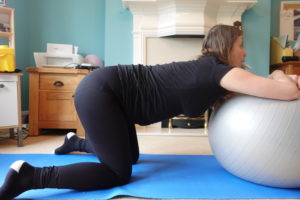How to recover after a caesarean?
All the steps needed to get in shape
Part 1: D0-D21
Too often forgotten that caesarean section is not a classic delivery, but abdominal surgery. The recovery is therefore very different from a traditional childbirth. You have to give the body more time to heal without rushing it.
The first days after caesarean section are days of healing. Do not rush your body, it heals very well if you do not force, so let it rest.
Although it is not always easy with a newborn at home, there are movements to avoid.
Healing is done in the lower part of the abdomen, making it sensitive to all abdominal pressures. It will thus be necessary to protect this abdomen at the beginning by avoiding too much solicitation of the abdominals muscles not to push on the scar. For more info on how abdominal pressure is influenced have a look at our previous article:
https://myfrenchphysio.london/womenhealth-obstetric/obstetric-post-natal-pelvic-floor/good-and-bad-abdominal-exercises/
So let see how to avoid to contract our abdominal too much! Especially when coughing, sneezing or laughing!
How to cough?
The first thing to do is to learn how to cough without pushing! Not easy to understand in theory but finally quite simple:
Place your 2 hands under the lower abdomen (under the healing) and when coughing, raise the belly with your hands while tightening the perineum and tilting the pelvis backwards as to round the lower back (yes it asks for practice!), train during pregnancy (since it’s the same thing: protect your perineum and abs).
The pelvic belt
During a traditional delivery, the pelvis closes when the baby is expelled. Let me explain: the top of the pelvis closes to push the baby into the small pool and expel the baby during the labour.
With a caesarean, this movement is not done by itself. It will therefore be necessary to close the basin mechanically. The physiomat belt that I praise during pregnancy, will be able to serve you to close the pelvis. The principle is simple: a devise that tightens your pelvis to close it.
The abdominal belt
Those who know me know that I hate this kind of belt! The first 3 weeks post-partum are the only time I tolerate the belt. Your abdominal muscles heal but you still ask them in the wrong direction by carrying your baby, changing position …
To avoid a diastasis, it will be necessary to solicit them in the right way of the contraction and avoid pushing too hard.
To protect them, the belt is ideal. But despite this belt, it will be necessary to continue to contract some of your abdominals in the “right way”. And you can do that thanks to the whistle that I discuss below in this article.
Position change
Not always easy to change position with a baby in the arms without pulling on his healing. Here are some little secrets:
- From the lying position to the seated position (and vice versa): I turn on the side and push on my arms to sit up.
- From sitting to standing: I lean forward and push on my knees with my hands to stand up
- From standing to sitting: I bend my knees up and take the buttocks backwards
- To catch baby in bed: I make a split with the legs bending the knees as much as possible, then I lean forward and stick baby in the chest before straightening with baby in the arms.I never catch my baby with the arms, the lever arm will be too important to heal.
Breastfeeding positions
The only breastfeeding position that is safe at this stage is the lying position on the side. I know it’s not always easy, but the sitting position requires baby to carry, so there is a risk of pulling on the heal if the feeding takes a while.
Perineum exercises
It’s not because you had a caesarean section that your perineum was not weakened by the pregnancy. So, from birth, we begin to squeeze our perineum gently by doing fast squeezes.
Blowing, I contract the perineum as to retain a need to pee and gas at the same time without tending my stomach. You can repeat this movement a dozen times and several times a day (lying down or sitting only, your perineum will not be strong enough to have a good standing contraction).
Whistle, the abdo-mg method
Modulated breath integration in stimulated abdominal rehabilitation guarantees a protective aspect allowing early management after childbirth and after any abdominal surgery.
The main objective of the ABDO-MG concept is to allow everyone to recover a competent abdominal belt, motor of the breath and to integrate good reflexes in the daily actions.
As I hope you have understood, reading us, this period is a recovery time so enjoy it!
And if you feel like you could need extra help at home to learn how to settle with your newborn, have a look at:
https://myfrenchphysio.london/treatment/home-visits-for-mum-newborn/



